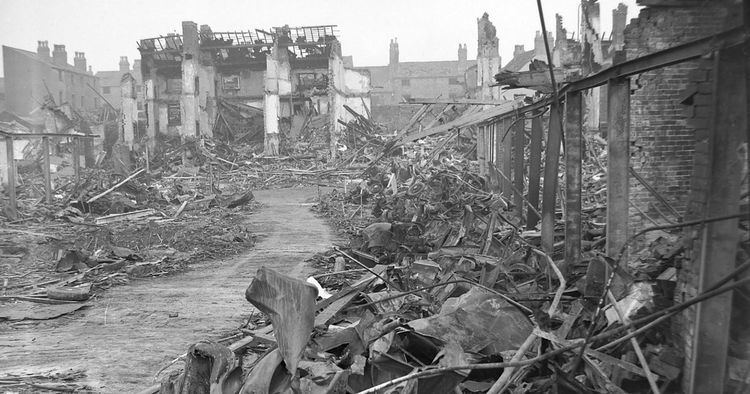 | ||
The Birmingham Blitz was the heavy bombing by the Nazi German Luftwaffe of the city of Birmingham and surrounding towns in the United Kingdom, beginning on 9 August 1940 and ending on 23 April 1943. It is considered a part of the greater Blitz, which was part of the Battle of Britain. Situated in the Midlands, Birmingham, England's most populous British city outside London, is an important industrial and manufacturing location. In total around 1,852 tons of bombs were dropped on Birmingham, making it the third most heavily bombed city in the United Kingdom in World War II, behind only London and Liverpool.
Contents
- Damage
- Timeline of events
- Black Country
- Important industrial targets
- Decorations
- Memorial
- Aftermath
- References
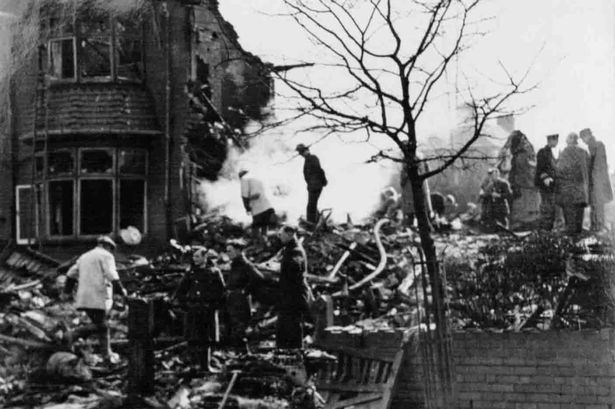
There was also significant bombing of towns in the neighbouring Black Country, particularly in Dudley, Tipton and West Bromwich, where there were hundreds of casualties.

As with most provincial cities bombed during the Blitz, reports of the bombing were kept low key. Wartime censorship meant that Birmingham was not mentioned by name in contemporary news reports about the bombing, being referred to instead as a "Midland Town". This was done in order to keep the Germans from knowing the outcome of their raids.
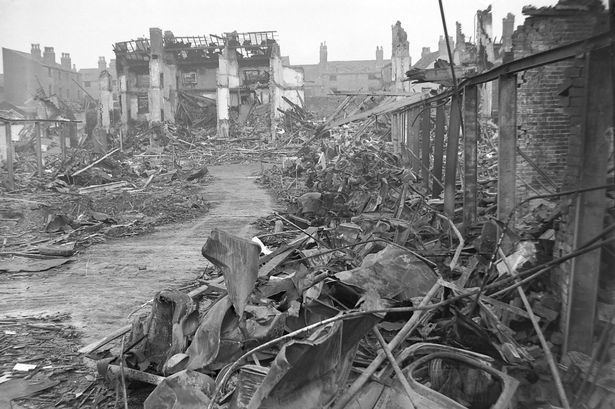
Damage
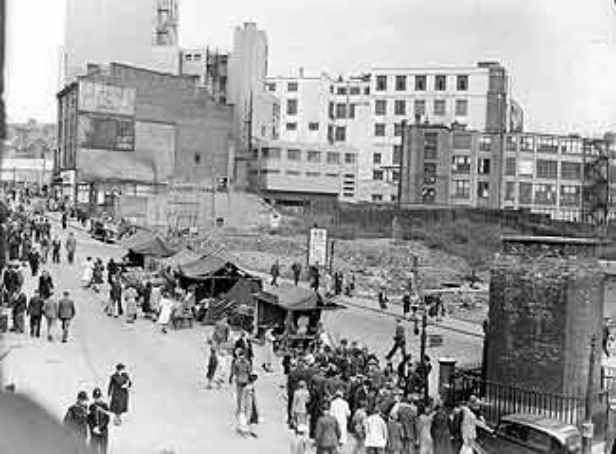
Overall, there were 365 air raid alerts, and 77 actual air raids on Birmingham, eight of which were classified as major (in which at least 100 tons of bombs were dropped). Official figures state that 5,129 high explosive bombs and 48 parachute mines landed on the city, along with many thousands of incendiary bombs. Of the high explosive bombs, around one fifth failed to detonate and one third of the parachute mines were left suspended after the parachute cords became caught in various obstacles such as trees. In total, 2,241 people were killed, and 3,010 seriously injured. A further 3,682 sustained lesser injuries. 12,391 houses, 302 factories and 239 other buildings were destroyed, with many more damaged.
Timeline of events

The first air raid on the city took place on 9 August 1940, carried out by a single aircraft which dropped its bombs on Erdington. One person was killed, and six injured. On 13 August the aircraft factory in Castle Bromwich which produced Spitfires was attacked. Eleven bombs hit the main target causing significant damage. 7 people were killed, and 41 injured. The first raid on the city centre occurred on 25/26 August, 25 people were killed in the raid, and the roof and interior of the old Market Hall in the Bull Ring was destroyed after being set ablaze by incendiary bombs.
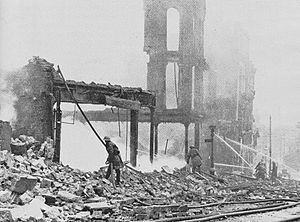
Regular small raids followed over August, September, October and early November. The city centre was badly hit between 25–30 October. Among the buildings hit were Birmingham University, the Art Gallery and the Town Hall. The roof of the Council House was damaged by fire, and on the 29th, St Philip's Cathedral suffered serious fire damage after being hit by an incendiary.
In November 1940, a series of heavy air raids on Birmingham took place. Between the 19th and 28th of that month around 800 people were killed and 2,345 injured, with 20,000 civilians made homeless.
On 19 November, just five days after the devastating attack on nearby Coventry, the first major air raid was launched against Birmingham, when around 440 bombers attacked the city, killing 450 people and badly injuring 540. Around 400 tonnes of high explosives were dropped during the raid, including 18 parachute mines. The raid turned out to be the most severe attack on Birmingham in the course of the war. A number of factories were badly damaged in the raid, including the Lucas Industries and GEC works. The Birmingham Small Arms Company (BSA) factory was badly damaged, causing loss of production and trapping hundreds of workers. 53 employees were killed, 89 were injured, 30 of them seriously, and rifle production was halted for three months. A member of the Home Guard and one of the company's electricians were later awarded the George Medal for their bravery in helping the trapped workers.
The following night 200 bombers returned for another heavy raid, dropping 118 tonnes of explosives and 9,500 incendiaries, causing widespread damage. The main bus depot in Hockley was among the buildings hit, destroying or damaging 100 vehicles.
A third consecutive major raid followed on 21/22 November. During this eleven-hour raid, large numbers of incendiaries were dropped, starting over 600 fires. The water supply system was badly damaged by bombs, causing three fifths of the city to lose mains water supply, firefighters therefore had to draw water from the city's canals. Supporting fire brigades from across the country were drafted in to help, and the fires were eventually brought under control. Nevertheless, Birmingham's water supply remained in a critical state, only one fifth of the normal quantity would have been available if there had been another raid, leading the Regional Commissioner to comment "Birmingham will burn down if the Luftwaffe comes again tonight." Fortunately, there wasn't another raid that night, and this gave engineers time to repair the water mains.
Around 60 bombers attacked Birmingham on 4 December. The Witton tram depot was badly damaged in this raid. One week later, on the night of 11 December another major raid involving 278 bombers was launched against the city. This was the longest raid of the Blitz lasting for 13 hours. Apart from explosives, around 25,000 incendiaries were dropped during the raid, causing widespread fires in both residential and industrial areas. 263 people were killed and 243 badly injured. All but the fine tower and classical west portico of St Thomas' Church on Bath Row was destroyed in the raid. Its ruins now form part of St. Thomas' Peace Garden, a public park designated as a monument to peace and a memorial to all those killed in armed conflict.
Further heavy raids followed in 1941, on 11 March 135 bombers attacked the city. On 9 and 10 April, Birmingham was subjected to two heavy raids. In the first of these, 235 bombers dropped 280 tonnes of explosives and 40,000 incendiaries, concentrated on the city-centre. The Bull Ring, New Street, High Street, and Dale End all suffered heavy damage, St Martin in the Bull Ring was damaged and the Prince of Wales Theatre and Midland Arcade were destroyed. Other areas including Small Heath, Aston and Nechells, also suffered heavy damage. On the second night, 245 bombers dropped 245 tonnes of explosives and 43,000 incendiaries, causing major damage in Solihull, Hall Green and Erdington. The two April raids caused 1,121 casualties.
On the night of 16 May, another large raid caused damage to the Wolseley Motors factory, and the ICI factory. Although a navigation error meant that most of the bombers dropped their bombs on nearby Nuneaton by mistake.
The last significant raid on Birmingham came on 27 July 1942, when around 60 to 70 bombers attacked the city. The very last raid on the city came on 23 April 1943 when just two bombs fell on Bordesley Green, causing slight injury, and the last air raid siren sounded on 15 May 1944.
Black Country
The Black Country area also suffered from air raids from the Luftwaffe aiming for targets there and in Birmingham, although there was less damage and fewer casualties in the Black Country than in Birmingham. These included:
Important industrial targets
Other targets included: Dunlop, Chance Brothers, Lucas, Metro-Cammell, Morris Commercial, British Timken, Hudson's Whistles and the Monitor Radio Company.
Decorations
Several service people were decorated for their heroism during the blitz. They include:
Memorial
On 8 October 2005 a memorial sculpture, named 'The Tree of Life' sculpted by Lorenzo Quinn, dedicated to the victims of the Blitz was unveiled adjacent to St Martin’s Church.
Aftermath
The massive bomb damage on civilian housing in Birmingham contributed to the development of many large council estates across the city for some 20 years after the Second World War. These neighbourhoods included Castle Vale and Chelmsley Wood. Another major factor in the construction of these new properties was to replace the 19th century slums in the inner city areas.
Some of the bomb-damaged inner city areas such as Ladywood and Highgate were redeveloped with modern housing after the war, although these were mostly less densely populated than before.
